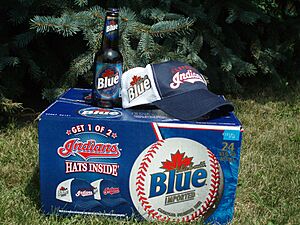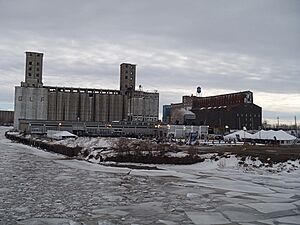Labatt Brewing Company facts for kids
 |
|
| Subsidiary | |
| Industry | Alcoholic drink |
| Founded | 1847 |
| Founder | John Kinder Labatt |
| Headquarters | , |
|
Number of locations
|
Six (London, St. John’s, Montreal, Halifax, Creston, Edmonton) |
| Products | Beer |
| Parent | Anheuser-Busch InBev |
| Subsidiaries | The Beer Store (49%), Brewers' Distributors Limited (50%) |
Labatt Brewing Company Limited (which is called La Brasserie Labatt Limitée in French) is a big company in Canada that makes beer. Its main office is in Toronto, Ontario. Labatt was started in 1847 and is now the largest beer maker in Canada.
In 1995, a Belgian company called Interbrew bought Labatt. Later, in 2004, Interbrew joined with a Brazilian company called AmBev to create InBev. Then, in 2008, InBev and an American company called Anheuser-Busch came together to form Anheuser-Busch InBev. This made Labatt part of this new, very large company.
In the United States, Labatt beers are sold by Labatt USA. Since 2009, this part of the company has been separate from the Canadian Labatt firm. It is now owned by a company called FIFCO USA, located in Rochester, New York.
Contents
History of Labatt
Labatt Breweries was started by John Kinder Labatt in 1847. It began in London, which was then called Canada West. John Kinder Labatt moved to Canada from Ireland in the 1830s. He first worked as a farmer near London. In 1847, he invested in a brewery with a partner, Samuel Eccles. Their company was called "Labatt and Eccles."
When Samuel Eccles left the business in 1854, John Kinder Labatt took over completely. He changed the company's name to the "London Brewery." His sons Ephraim, Robert, and John helped him run the business.
When John Kinder Labatt passed away in 1866, his son John took charge. Under his leadership, Labatt grew to become the biggest brewery in Canada. After John's death in 1915, his nine children controlled the company. His sons John Sackville Labatt and Hugh Francis Labatt managed the daily operations.
Surviving Prohibition
In the early 1900s, laws called "Prohibition" started in Canada. These laws made it illegal to sell alcohol. In 1916, Prohibition came to Ontario, affecting many breweries. Some provinces allowed beer to be made for export to the United States. Labatt survived by making strong beer to sell in the US. They also made two "temperance ales" with very little alcohol for sale in Ontario.
The Canadian beer industry faced another challenge when Prohibition began in the United States in 1919. When Prohibition ended in Ontario in 1926, only 15 breweries were left. Labatt was one of the few that still had its original management. This helped the company become even stronger. In 1945, Labatt became a publicly traded company. This meant people could buy shares of the company.
Popular Beers and Ownership Changes
In 1950, John and Hugh Labatt, who were grandsons of the founder, launched Labatt 50. This beer celebrated 50 years of partnership. Labatt 50 was the first light-tasting ale in Canada. It was Canada's best-selling beer until 1979.
By the 1960s, John S. Labatt and Hugh Labatt had both passed away. John Moore became Labatt's president. In 1964, an American company called Schlitz bought most of Labatt. However, this ownership did not last long. By 1966, Schlitz sold its share back to a group led by John Moore. This brought Labatt back under Canadian ownership.
In 1951, Labatt launched its Pilsener Lager. When it was introduced in Manitoba, people started calling it "Blue." This was because of its blue label and because the company supported the Winnipeg Blue Bombers, a football team. The name "Blue" stuck. In 1979, Labatt Blue became the top-selling beer in Canada. It lost this spot later but often regained it. In 2004, another beer called Budweiser became the top seller. Labatt brews Budweiser in Canada, so this change did not hurt Labatt much. Labatt Blue is still the best-selling Canadian beer in the world.
Labatt also owned most of the Toronto Blue Jays baseball team from 1976 until 1995. This was when Interbrew bought Labatt. Later, in 2000, Rogers Communications bought most of the team.
Innovations and Recent History
Labatt has introduced new ideas over the years. In 1984, they launched the first twist-off cap on a bottle that could be refilled. In 1989, a Canadian model named Pamela Anderson became famous after being seen at a football game wearing a Labatt's Blue shirt. A photographer made a poster of her, and Labatt's later bought many of them because people wanted them.
In 1995, Labatt was bought by Interbrew, a large Belgian company. Labatt also partly owns The Beer Store, a chain of stores that sells beer in Ontario. In 2007, Labatt bought another company called Lakeport Brewing Company.
In 2009, Labatt sold Labatt USA. This included the rights to sell Labatt beers like Blue and Labatt 50 in the United States. This sale was required by the US government. It was to make sure there was fair competition after InBev joined with Anheuser-Busch.
The sale did not include other Labatt products like Kokanee or Alexander Keith's. These are now sold in the US by Anheuser-Busch. However, Labatt still owns the Labatt brand name and other important things. The sale also did not change Labatt's operations in Canada.
In 2020, Labatt bought a Canadian company called Goodridge & Williams. This company is known for making Nütrl Vodka Soda and other ready-to-drink canned drinks.
Where Labatt Operates
Labatt has breweries and offices in several places.
Canadian Locations
- London, Ontario
- St. John's, Newfoundland and Labrador
- Montreal, Quebec (in the LaSalle area)
- Halifax, Nova Scotia
- Creston, British Columbia
- Edmonton, Alberta
United States Operations
Labatt's main office in the US was first in Buffalo, New York. Then it moved to Norwalk, Connecticut, for a while. In 2007, Labatt decided to move its US operations back to Buffalo. This was because of strong sales there and being closer to their Canadian operations. Labatt USA is now owned by FIFCO USA.
Labatt's brewery in Toronto was built in 1970. It stopped making beer in 2005 and was taken down by 2007.
Labatt Beer Brands
Labatt 50 is an ale that was launched in 1950. It celebrated 50 years of partnership between the founder's grandsons. It was the first light-tasting ale in Canada. Labatt 50 was Canada's best-selling beer until 1979.
Labatt Blue is a pale lager. It is the company's main brand. In 2003, Labatt Blue won a Gold Quality Award at the World Quality Selections.
In Quebec, Labatt also makes a stronger lager called Labatt Bleue Dry.
Labatt has a special way of making ice beer. They explain it like this: "During this unique process, the temperature is reduced until fine ice crystals form in the beer. Then using an exclusive process, the crystals are removed. The result is a full flavoured balanced beer." This process is used for beers like Labatt Ice and Maximum Ice.
Labatt's Community Activities
Labatt has helped build many buildings in London, Ontario. These include Labatt Park, the John Labatt Centre, and the John Labatt Visual Arts Centre at the University of Western Ontario (UWO).
Labatt has also sponsored sports teams and events. They sponsored the English football team Nottingham Forest F.C. from 1992 to 1997. They are also the official beer sponsor of the Plymouth Whalers hockey team. In the 1950s, the company sponsored a golf tournament called the Labatt Open.
Labatt sponsored race car driver Gilles Villeneuve. They were also the main sponsor of the Formula One Canadian Grand Prix car race from 1972 to 1986. They also sponsored the Williams F1 racing team from 1991 to 1994.
From 1983 to 1986, Labatt sponsored Ken Westerfield, a Canadian Frisbee champion. He performed Frisbee shows across Ontario. Labatt also sponsored the World Guts (Frisbee) Championships in Toronto in 1986.
Labatt sponsors the yearly Labatt Blue Buffalo Pond Hockey Tournament in Buffalo, New York. This outdoor hockey tournament for amateur players has more than 800 participants.
In May 2009, Labatt supported the idea of having a seventh NHL hockey team in Canada.
In November 2018, Labatt USA opened the Labatt Brew House in Buffalo, New York. It is a special brewery and tasting room. Visitors can try new experimental beers or choose from popular ones.
Marketing Labatt Blue
Labatt Blue is sold in all parts of Canada. However, in Quebec, it is called Labatt Bleue and has a fleur-de-lis logo. The red maple leaf on the logo is changed to a red sheaf of wheat in Quebec. Labatt says this wheat symbol stands for "brewing quality."
Labatt Blue is also sold in most of the United States. It is especially popular in the Midwest and Northeast regions, close to the Canada–United States border.
Honours for Labatt
Coat of Arms
|
In 2017, Labatt was given a special design called a "coat of arms" by the Canadian Heraldic Authority. This coat of arms includes symbols that represent the company.
- The spearhead was an old Labatt symbol. It shows the company's strength and its important role in making beer in Canada.
- The hop plant is used to flavor beer. It reminds us of Labatt's focus on realness, quality, and being good for the environment.
- The gold color celebrates the many awards Labatt products have won over the years.




